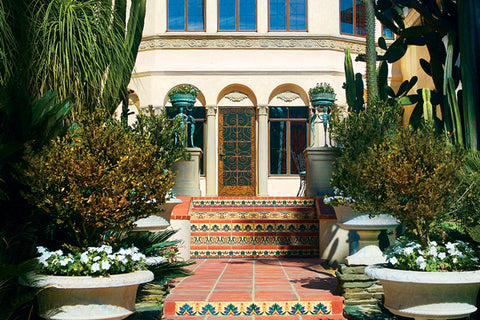Cornelius-Clifford Mansion on Foothill Road

Among all the showplace homes in Beverly Hills, this Foothill Road estate is by far, one of a kind. The sprawling Spanish-Moorish residence is the only pre-World War II mansion on an estate-sized lot in the Beverly Hills flats. To many residents, it’s the north-of-Sunset property that got lost and ended up south of Sunset in the flats. The mansion also acquired an air of mystery among its immediate neighbors, for reasons that involved more than its larger-than-life size and exotic architecture: the lack of activity – particularly the lack of parties – for an establishment of its grandeur. Real events – and occasional reports from its servants to the neighbors – proved that it was never your everyday Beverly Hills mansion.
Ruth Clifford was one of the brightest silent-movie stars, and at fifteen moved to California to live with an aunt. Immediately she became entranced by the new business of silent pictures. She was a pretty, petite, blue-eyed blond with a certain way about her, and the pictures – likewise became entranced with her. She was an extra for Edison’s local film company until she was spotted by a director at Carl Laemmle’s Universal Studios and immediately signed.
Then, as now, a lovely, talented, and famous young star had many fans, and suitors. In 1924, Clifford married James Cornelius, scion of a notable East Coast patrician family, vice president of the State Bank of Beverly Hills, and one of the leaders in the Beverly Hills real estate sales and development market. Cornelius constructed dozens of homes throughout the Beverly Hills flats. For their honeymoon, the couple sailed to Honolulu to spend a month in Hawaii; the bride took “only” five trunks to a hold a “trousseau composed for twenty-two complete outfits, varying from evening gowns to sport costumes.”
Upon their February 1925 return to California, James Cornelius and Ruth Clifford moved into their new Foothill Road home. It was a startling sight in the fashionable Beverly Hills flats. The mansion was much larger than its neighbors and more shocking – it occupied a one-acre double lot. It was one of the few estate-sized properties south of Sunset Boulevard. The Cornelius-Clifford mansion was an imposing presence in the neighborhood. The thick stucco walls, wrought-iron balconies, beautiful cast-stone embellishments surrounding the windows and atop the massive chimneys, as well as the façade’s centerpiece- a soaring trifoliate window – all gave the mansion the improbable air of a land-locked Venetian palazzo.
Inside, the large, low-ceilinged rooms had only a few windows, which not only reflected the Spanish sensibility popular at the time but also served the practical purposes of keeping the living areas cool in the summer and protecting furnishing from exposure to the sunlight.
A new family purchased the home in the 1950s, but it remains in their family today, a splendidly preserved reminder of the splendor of 1920s Beverly Hills.





